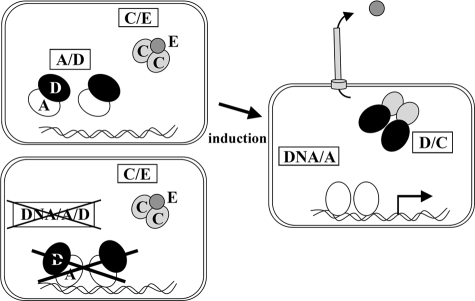FIGURE 7.
Model of ExsD inhibitory role on ExsA. Under noninducing T3SS conditions, ExsD captures ExsA within a 1:1 complex, making the transcription activator unable to bind target promoters. The second putative mechanism of inhibition, implying the DNA-binding of an ExsA-ExsD complex inefficient in transcriptional activation, was ruled out. The two other components of the regulatory cascade coupling T3SS secretion and synthesis, ExsC and ExsE, can form a 2:1 complex (11, 26). Upon induction of the T3SS system, ExsE is translocated into host cell, and the free ExsC protein interacts with ExsD. Released ExsA then binds to DNA and activate T3SS operons.

